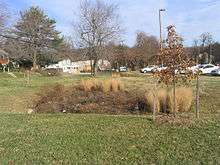Bioretention
Bioretention is the process in which contaminants and sedimentation are removed from stormwater runoff. Stormwater is collected into the treatment area which consists of a grass buffer strip, sand bed, ponding area, organic layer or mulch layer, planting soil, and plants. Runoff passes first over or through a sand bed, which slows the runoff's velocity, distributes it evenly along the length of the ponding area, which consists of a surface organic layer and/or groundcover and the underlying planting soil. The ponding area is graded, its center depressed. Water is ponded to a depth of 15 cm (5.9 in) and gradually infiltrates the bioretention area or is evapotranspired. The bioretention area is graded to divert excess runoff away from itself. Stored water in the bioretention area planting soil exfiltrates over a period of days into the underlying soils.[1]

Filtration
Each of the components of the bioretention area is designed to perform a specific function. The grass buffer strip reduces incoming runoff velocity and filters particulates from the runoff. The sand bed also reduces the velocity, filters particulates, and spreads flow over the length of the bioretention area. Aeration and drainage of the planting soil are provided by the 0.5 m (20 in) deep sand bed. The ponding area provides a temporary storage location for runoff prior to its evaporation or infiltration. Some particulates not filtered out by the grass filter strip or the sand bed settle within the ponding area.[1]
The organic or mulch layer also filters pollutants and provides an environment conducive to the growth of microorganisms, which degrade petroleum-based products and other organic material. This layer acts in a similar way to the leaf litter in a forest and prevents the erosion and drying of underlying soils. Planted groundcover reduces the potential for erosion as well, slightly more effectively than mulch. The maximum sheet flow velocity prior to erosive conditions is 0.3 meters per second (1 foot per second) for planted groundcover and 0.9 meters per second (3 feet per second) for mulch.[2]
The clay in the planting soil provides adsorption sites for hydrocarbons, heavy metals, nutrients and other pollutants. Stormwater storage is also provided by the voids in the planting soil. The stored water and nutrients in the water and soil are then available to the plants for uptake. The layout of the bioretention area is determined after site constraints such as location of utilities, underlying soils, existing vegetation, and drainage are considered. Sites with loamy sand soils are especially appropriate for bioretention because the excavated soil can be backfilled and used as the planting soil, thus eliminating the cost of importing planting soil. An unstable surrounding soil stratum and soils with a clay content greater than 25 percent may preclude the use of bioretention, as would a site with slopes greater than 20 percent or a site with mature trees that would be removed during construction of the best management practices.[3]
Heavy metal remediation
Contaminant trace metals such as zinc, lead, and copper are found in stormwater runoff from impervious surfaces (e.g. roadways and sidewalks). Treatment systems such as rain gardens and stormwater planters utilize a bioretention layer to remove heavy metals in stormwater runoff. Dissolved forms of heavy metals may bind to sediment particles in the roadway that are then captured by the bioretention system. Additionally, heavy metals may adsorb to soil particles in the bioretention media as the runoff filters through.[4] In laboratory experiments, bioretention cells removed 94%, 88%, 95%, and >95% of zinc, copper, lead, and cadmium, respectively from water with metal concentrations typical of stormwater runoff. While this is a great benefit for water quality improvement, bioretention systems have a finite capacity for heavy metal removal. This will ultimately control the lifetime of bioretention systems, especially in areas with high heavy metal loads.[5]
Metal removal by bioretention cells in cold climates was similar or slightly lower than that in warmer environments. Plants are less active in colder seasons, suggesting that most of the heavy metals remain in the bioretention media rather than being taken up by plant roots.[6] Therefore, removal and replacement of the bioretention layer will become necessary in areas with heavy metal pollutants in stormwater runoff to extend the life of the treatment system.
See also
- Bioswale
- Groundwater recharge
- Rain garden
- Urban runoff
- Phytoremediation
- Tree Box Filter
References
- Storm Water Technology Fact Sheet: Bioretention (Report). Washington, D.C.: U.S. Environmental Protection Agency (EPA). September 1999. EPA-832-F-99-012.
- Clar, M.L.; Barfield, B.J.; O’Connor, T.P. (2004). Stormwater Best Management Practice Design Guide, Volume 2: Vegetative Biofilters (Report). Cincinnati, OH: EPA. EPA-600/R-04/121A.
- Bioretention Manual (PDF) (Report). Largo, MD: Prince George's County Department of Environmental Resources. 2009. pp. 6, 42. Archived from the original (PDF) on 2011-01-08.
- Li, H., & Davis, A. P. (2008). doi:10.1021/es702681j "Heavy metal capture and accumulation in bioretention media." Environmental science & technology, 42(14), 5247-5253.
- Sun, X., & Davis, A. P. (2007)."Heavy metal fates in laboratory bioretention systems." Chemosphere, 66(9), 1601-1609.
- Muthanna, T. M., Viklander, M., Gjesdahl, N., & Thorolfsson, S. T. (2007)."Heavy metal removal in cold climate bioretention." Water, air, and soil pollution, 183(1-4), 391-402.
- Davis, Allen P. (2007). "Field Performance of Bioretention: Water Quality". Environmental Engineering Science. 24 (8): 1048–1064. doi:10.1089/ees.2006.0190.
- Liu, Jia; Sample, David J.; Bell, Cameron; Guan, Yuntao (2014). "Review and Research Needs of Bioretention Used for the Treatment of Urban Stormwater". Water. 6 (4): 1069–1099. doi:10.3390/w6041069.
- Traver, Robert G.; Davis, Allen P.; Hunt, William F. (October 2007). "Bioretention and Bioinfiltration BMPs: Three researchers' experience". Stormwater. Santa Barbara, CA: Forester Media. ISSN 1531-0574. Archived from the original on 2015-04-02.